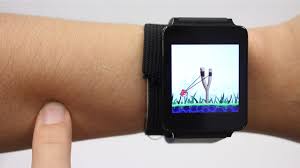Touchscreen News
Skintrack Will Turn Your Skin into a Touchscreen
Wouldn’t it be great if you could control your smartphone or tablet simply by pressing against your skin? Well, that’s exactly what a team of researchers at Carnegie Mellon are working to develop.
Known as “SkinTrack,” it uses electrodes to essentially turn the user’s skin into a fully functional touchpad for wearable electronics. It features a total of four paires of electrodes, all of which are embedded in a wristband, along with a ring that’s placed on the index finger to create an electrical signal for the corresponding touch. SkinTrack’s electrodes identify the signal produced by the ring to determine the location of your touch.
Some people may turn their heads at the thought of a device like SkinTrack being used in any real-world application. After all, how accurate it can really be? Well, researchers behind the project claim it’s 99% accurate at segmenting touch events, which is pretty impressive to say the least. The team further reiterated that SkinTrack is able to resolve the 2D location of touch with a mean error of just 7.6.mm.
“SkinTrack measures these phase differences to compute a 2D finger touch coordinate. Our approach can segment touch events at 99% accuracy, and resolve the 2D location of touches with a mean error of 7.6mm. As our approach is compact, non-invasive, low-cost and low-powered, we envision the technology being integrated into future smartwatches, supporting rich touch interactions beyond the confines of the small touchscreen,” explained researchers behind the project.
Why would you event want to use your skin as a touchpad? Well, one reason is because it offers a larger surface. If you need to perform a command on a smartwatch, you may find it difficult to touch the small icons on the display. However, touching the skin on your wrist would make this process easier, simply because you’ll have access to a larger surface area for touching.
Of course, other companies are also working on their versions of skin-based touchscreen technology. Whether or not these concepts will be translated into ready-to-market products, however, remains to be seen. In any case, it certainly opens the doors to a whole new world of possibilities. If you look back at technology just 10 years ago, the advancements that have been made are pretty remarkable. So there’s no telling what’s in store for the next ten years. We could very well see skin-based touch technology like SkinTrack being used for smartphones and wearable electronics.

